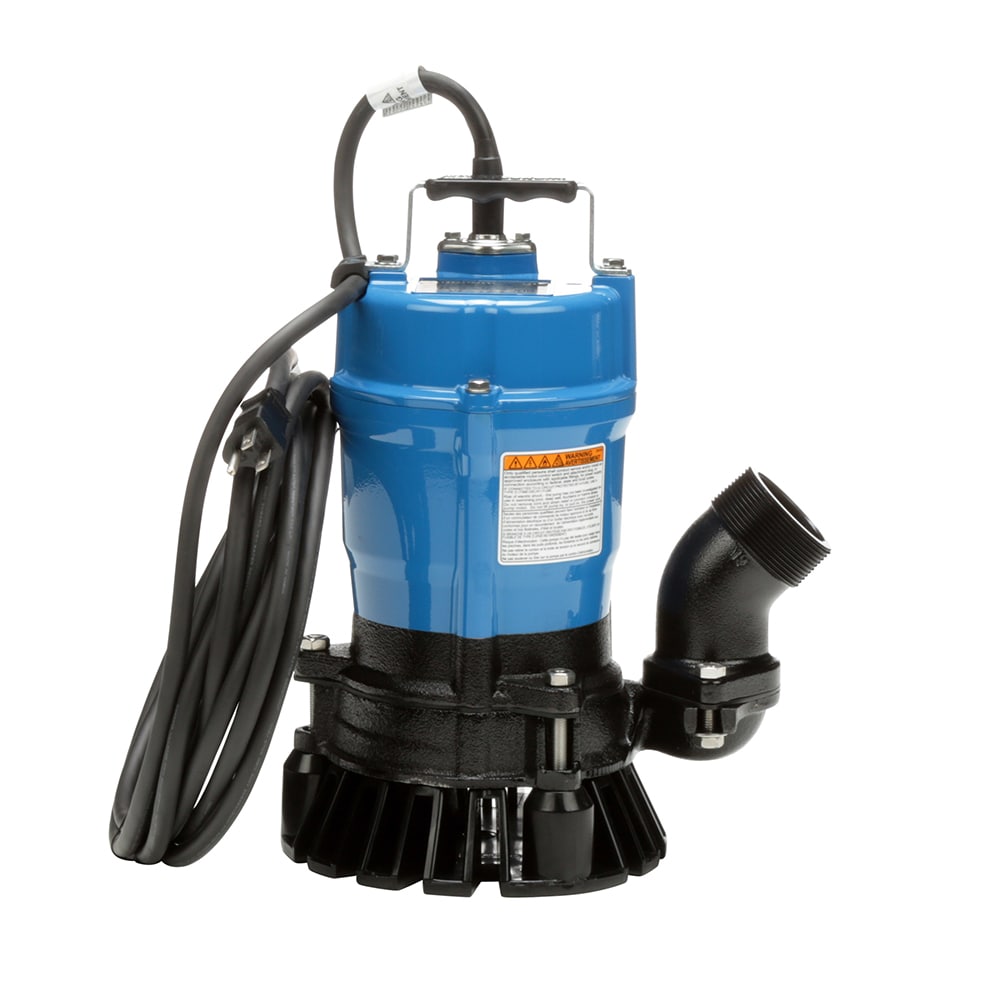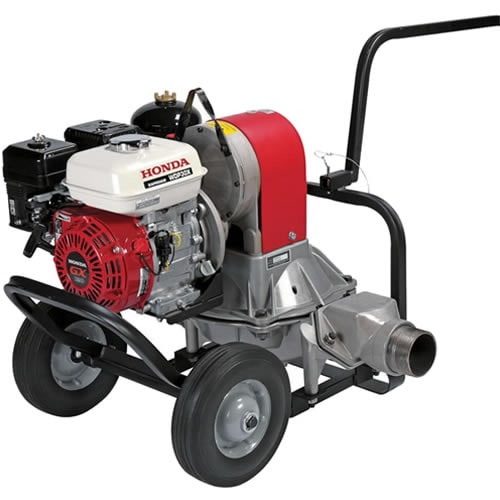
Flooding: A Prep and Clean Up Guide
Flooding is scary. It can happen anytime, anywhere, and causes damage without discretion. In fact, flooding events have the second-highest mortality rate of all weather -events in the United States1. During times of extreme weather (like a hurricane), water will always try to find its way into your home or basement.
Don't worry; this guide will give you the tools you need to prepare for, handle, and clean up flood damage—so if a storm approaches unexpectedly, you'll know exactly what you need to do.

How to Prepare for a Flood
Never underestimate flood warnings from weather services. Being overprepared beforehand can make the difference for your safety, thousands of dollars in flood damages and the loss of irreplaceable valuables.
The most important thing to remember is that you can't control mother nature, but you can react to it. Having a plan in place (and a water pump available) before a flood occurs is the best way to react quickly to emergencies and protect your home from water damage so long as it remains safe to do so.
Make a Flood Plan
Most cities and towns have established flood plans or evacuation/emergency procedures, especially in areas that are at higher risk for flooding. Check your local or federal government websites first to learn what plans are already available to you.
Flood Insurance is the simplest way to protect your home and your family while giving you some peace of mind. If flooding occurs, you'll be protected from the dizzying costs of flood damage, and makes the decision to evacuate easier.
Prepare an emergency kit that contains food, water, prescriptions, flashlights, and other emergency supplies. After your flood plan is in place, make sure your family knows what to do during a flood, like where to find emergency supplies, how to stay safe, and where to go in case of evacuation. Remember to include plans to keep your pets safe as well.
Know when to evacuate. Listen to the emergency warnings from weather sources and local news stations. If authorities tell you to evacuate, evacuate. No possessions are worth your life. If you have time before you leave home, follow the steps below.
Minimize Risks
Whether you decide to stay in your home or need to evacuate, there are a few things you can do to minimize the risk of flood damage to critical items in your home.
- Move valuables and other items out of the basement to upper levels of the home
- Elevate appliances like heating systems or appliances off the floor if possible
- Secure hazards like electrical wires or electrical utilities to stay away from water
- Protect other items with using waterproof storage containers
- Clean gutters and downspouts prior to heavy rainfall
Check Your Sump Pump System
Your sump pump is your home's first line of defense against flooding caused by a rising water table from heavy rainfall. Unfortunately, no sump pump will protect your home from flash floods or massive flooding from hurricanes. Regardless, make sure to test your sump pump and all of its components, and invest in a battery backup system to make sure your setup can handle surges of draining water during emergencies and power failures.
It can't be stressed enough how important it is to have a working sump pump system that is properly sized for emergency situations. If your primary sump pump isn't working quickly enough (or it burns out and fails), the backup pump will kick on and help prevent flooding.

What to Do in a Flood
Sometimes flash flooding occurs without warning, and it's important to be able to react accordingly. If you are caught in a flood:
- Monitor Your Basement
The best way to manage flooding risks is to actively monitor your sump pump, and check areas of your home that are at risk for flooding. Make sure there are no clogs in your pit, and that your sump pump system is working properly. - Go Over the Plan
Collect your family members and pets and go over your flood plan. Make sure everyone understands the risks and takes the proper precautions to keep them safe. Have your emergency kit items collected and ready to transport if needed. Everyone in your home should know where these items are. Keep them easily accessible on the upper levels of your home to minimize the risk of being damaged. - Tune In
Listen to the news and weather channels on television or radio. Be ready to react if evacuation notices are issued, and stay updated with information and news about storm predictions. Where available, check live news feeds and weather apps on your smartphone. - Move Valuables to Higher Ground
Remove the valuables from your basement and store them on higher levels of the home. For the things that cannot be moved from the basement, safely try to elevate those items off the ground. - If a Flood Warning is Issued:
Immediately disconnect power and utilities (like gas lines) in flooded areas. You never want to be around live electricity and water at the same time. If water is already in contact with electrical wiring or equipment, or you are standing in water, do not touch it. - Know When to Go
If your home starts to flood, or authorities issue an evacuation notice, be ready to move your family to safer, higher ground, or grab your bug-out bag and go if it is safe to do so. Never leave your home if your property outside is underwater. If it is, get to the highest point in your home.

How to Clean Up After a Flood
You've done all you can with the time you had, but sometimes there's still damage to clean up after a flood. Once it's been declared safe to return home, you should do the following:
- Assess the Damage
The first thing you should do is call your insurance company and notify them of the situation. They might have additional advice and information to give you as well, and you'll at least begin the restoration process. - Remove Items From Flooded Area
Once you have the power turned off and it is safe to enter the flood, start removing any items from the area. Start with any electronics, because they are usually affected most by water, and then remove any furniture, carpet, and anything else in the flooded area. - Clear Out the Water Quickly
After the area is clear, it’s time to clear out any remaining water. Having a utility or submersible trash pump makes short work of leftover flood water in and around your home without exposing yourself to dangerous contamination in standing water. Use a wet/dry vacuum for smaller areas, or even a water pump (see our recommendations below). In a pinch, you can also use a bucket, mop, or towels. - Dry the Area Out
With the water cleared away, it’s time to dry out the flooded area. Open up all of your basement windows and use fans and a portable dehumidifier to remove moisture from the air. Drying out the flooded area is one of the most important steps in preventing mold growth. - Disinfect the Area
Once the flooded area is dried out, it is important to disinfect it to make sure any bacteria that may have come from any sewers or drains are killed immediately. - Drywall and Mold
Flood conditions create the perfect environment for mold growth, so it is very important to clean the area with a bleach product before hanging up the mop. However, in cases of basements with drywall, there is little you can do to prevent molding in drywall even after drying it out. In short, don't take any chances and have the affected drywall replaced.
The Best Water Pumps for Flood Cleanup
Cleaning up after a flood isn't fun, but having the right water pump can accomplish a day's work in just a few hours. Below are our recommendations for the best types of water pumps for removing flood water.
Gas Trash Pumps

(170 - 1,000 GPM) If there's debris in the floodwater, and you're worried a dewatering pump may get plugged up, consider a gas trash pump. Trash pumps are designed a bit differently to be able to handle small solids.
If the flood water has affected your garden, or if it's spreading to your property from elsewhere, it's possible there may be bits and pieces of vegetation or other small debris floating in the water.
Gas Diaphragm Pumps
(33 - 92 GPM) If you've got a lot of water to move but are worried the water is contaminated with chemicals or oil, a gas-powered diaphragm pump may be the way to go. These pumps are capable of moving large amounts of water quickly and also pump chemicals and oils without corrosion to internal parts.
These pumps are very powerful, so be sure to use a durable hose and strainer or filter on your inlet/suction hose to ensure your pump doesn't get clogged with debris. If the flood water has affected your garden, or if it's spreading to your property from elsewhere, it's possible there may be bits and pieces of vegetation or other small debris floating in the water.
Submersible Trash Pumps

(53 - 150 GPM) If you need to remove standing water in harder to reach spaces in basements, garages, and crawl spaces, another option is to use a submersible trash pump. One benefit of these pumps is the fact they are completely submersible, not just the hose like on other units.
Trash pumps are ideal for basements, boats, or other small areas that may be hard to reach in some instances.
![]() NEXT: Shop All In-Stock Trash Pumps
NEXT: Shop All In-Stock Trash Pumps






